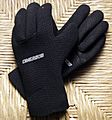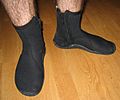Wetsuit facts for kids
A wetsuit is a special suit worn by people who go scuba diving, snorkeling, windsurfing, or surfing. It helps them stay warm in cold ocean water. Wetsuits let a thin layer of water in. This water gets warm from your body heat and acts like a cozy blanket, keeping you warm. Wetsuits are made from materials like neoprene, which is a type of rubber. They can cover your whole body, including your head, hands, and feet. Many people believe that Jack O'Neill invented the wetsuit.
Contents
Different Types of Wetsuits
Wetsuits come in different styles and thicknesses. The type you wear depends on how cold the water is and what activity you are doing.
Partial Wetsuits
When the water is not too cold, people might only wear parts of a wetsuit. This could be just a top that covers their body, or maybe just the leggings. These are often called "shorty" wetsuits. They are common on warm surf beaches, like those in Australia or Southern California. A "shorty" wetsuit covers your main body, but has short sleeves and short legs.
Full Wetsuits
People who dive deep or spend a lot of time in very cold water often wear full wetsuits. These suits cover your whole body. They include coverings for your body, legs, head, hands, and feet. This gives maximum warmth.
What About Dry Suits?
For extremely cold water, like in the Arctic Ocean, a dry suit is often used instead of a wetsuit. A dry suit is different because it keeps the diver completely dry. No water touches your skin inside a dry suit. This makes them perfect for very cold conditions.
Cool Facts About Wetsuits
- Most wetsuits are dark in color. This helps them soak up the sun's heat.
- They protect swimmers and divers. Wetsuits can guard against jellyfish stings. They also protect you from sharp reefs or rocks underwater.
- Wetsuits have tiny bubbles of nitrogen gas inside them. These bubbles help you float better in the water.
- The gas bubbles also help keep the person wearing the suit warm.
- Your body heat warms the thin layer of water trapped inside the wetsuit. This warm water helps keep you cozy.
- Wetsuits come in different thicknesses. The thickness depends on the water temperature. Most wetsuits are about 3 to 5 millimeters thick.
Images for kids
-
French diving gear manufacturer Georges Beuchat wearing the "isothermic" sponge-rubber wetsuit he invented in 1953
See also
 In Spanish: Traje acuático para niños
In Spanish: Traje acuático para niños












